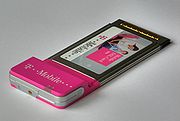
Wireless modem
Encyclopedia


Modem
A modem is a device that modulates an analog carrier signal to encode digital information, and also demodulates such a carrier signal to decode the transmitted information. The goal is to produce a signal that can be transmitted easily and decoded to reproduce the original digital data...
which connects to a wireless network instead of using telephone or cable television
Cable television
Cable television is a system of providing television programs to consumers via radio frequency signals transmitted to televisions through coaxial cables or digital light pulses through fixed optical fibers located on the subscriber's property, much like the over-the-air method used in traditional...
lines. A mobile Internet user can connect using a wireless modem to a wireless Internet Service Provider
Internet service provider
An Internet service provider is a company that provides access to the Internet. Access ISPs directly connect customers to the Internet using copper wires, wireless or fiber-optic connections. Hosting ISPs lease server space for smaller businesses and host other people servers...
(ISP) to get Internet access
Internet access
Many technologies and service plans for Internet access allow customers to connect to the Internet.Consumer use first became popular through dial-up connections in the 20th century....
.
Types of devices used
Mobile phoneMobile phone
A mobile phone is a device which can make and receive telephone calls over a radio link whilst moving around a wide geographic area. It does so by connecting to a cellular network provided by a mobile network operator...
s, smartphones, and PDA
PDA
A PDA is most commonly a Personal digital assistant, also known as a Personal data assistant, a mobile electronic device.PDA may also refer to:In science, medicine and technology:...
s can be employed as data modems to form a wireless access point connecting a personal computer to the Internet (or some proprietary network). In this use the mobile phone is providing a gateway
Gateway (telecommunications)
In telecommunications, the term gateway has the following meaning:*In a communications network, a network node equipped for interfacing with another network that uses different protocols....
between the cellular service provider's data network technology and Point-to-Point Protocol (PPP) spoken by PCs. Almost all current mobile phone models support the Hayes command set
Hayes command set
The Hayes command set is a specific command-language originally developed for the Hayes Smartmodem 300 baud modem in 1981. The command set consists of a series of short text strings which combine together to produce complete commands for operations such as dialing, hanging up, and changing the...
, a standard method of controlling modems. To the PC, the phone appears like an external modem when connected via serial cable, USB, IrDA
IRDA
IRDA may refer to:* Infrared Data Association, in information and communications technology , a standard for communication between devices over short distances using infrared signals...
infrared or Bluetooth
Bluetooth
Bluetooth is a proprietary open wireless technology standard for exchanging data over short distances from fixed and mobile devices, creating personal area networks with high levels of security...
wireless. Some cellular providers forbid this kind of usage, or charge an extra fee.
Wireless FireWire, USB and Serial modems are also used in the Wi-Fi
Wi-Fi
Wi-Fi or Wifi, is a mechanism for wirelessly connecting electronic devices. A device enabled with Wi-Fi, such as a personal computer, video game console, smartphone, or digital audio player, can connect to the Internet via a wireless network access point. An access point has a range of about 20...
and WiMAX
WiMAX
WiMAX is a communication technology for wirelessly delivering high-speed Internet service to large geographical areas. The 2005 WiMAX revision provided bit rates up to 40 Mbit/s with the 2011 update up to 1 Gbit/s for fixed stations...
standards, operating at microwave frequencies, to give a laptop, PDA or desktop computer an access point to a network. The modems may be as large as a regular cable modem to as small as a dongle
Dongle
A software protection dongle is a small piece of hardware that plugs into an electrical connector on a computer and serves as an electronic "key" for a piece of software; the program will only run when the dongle is plugged in...
or USB-stick
USB flash drive
A flash drive is a data storage device that consists of flash memory with an integrated Universal Serial Bus interface. flash drives are typically removable and rewritable, and physically much smaller than a floppy disk. Most weigh less than 30 g...
. If combined with Voice over IP
Voice over IP
Voice over Internet Protocol is a family of technologies, methodologies, communication protocols, and transmission techniques for the delivery of voice communications and multimedia sessions over Internet Protocol networks, such as the Internet...
(VoIP) technology, these computing devices can make and receive telephone calls.
PCMCIA, ExpressCard
ExpressCard
ExpressCard is an interface to allow peripheral devices to be connected to a computer, usually a laptop computer. Formerly called NEWCARD, the ExpressCard standard specifies the design of slots built into the computer and of cards which can be inserted into ExpressCard slots. The cards contain...
and Compact Flash modems are also used. These card-modems can also have GPS included.
History
While some analogueAnalogue electronics
Analogue electronics are electronic systems with a continuously variable signal, in contrast to digital electronics where signals usually take only two different levels. The term "analogue" describes the proportional relationship between a signal and a voltage or current that represents the signal...
mobile phones provided a standard RJ11 telephone socket into which a normal landline modem could be plugged, this only provided slow dial-up connections, usually 2.4 kilobit per second (kbit/s) or less. The next generation of phones, known as 2G (for 'second generation'), were digital, and offered faster dial-up speeds of 9.6kbit/s or 14.4kbit/s without the need for a separate modem. A further evolution called HSCSD used multiple GSM channels (two or three in each direction) to support up to 43.2kbit/s. All of these technologies still required their users to have a dial-up ISP
Internet service provider
An Internet service provider is a company that provides access to the Internet. Access ISPs directly connect customers to the Internet using copper wires, wireless or fiber-optic connections. Hosting ISPs lease server space for smaller businesses and host other people servers...
to connect to and provide the Internet access - it was not provided by the mobile phone network itself.
The release of 2.5G phones with support for packet data changed this. The 2.5G networks break both digital voice and data into small chunks, and mix both onto the network simultaneously in a process called packet switching
Packet switching
Packet switching is a digital networking communications method that groups all transmitted data – regardless of content, type, or structure – into suitably sized blocks, called packets. Packet switching features delivery of variable-bit-rate data streams over a shared network...
. This allows the phone to have a voice connection and a data connection at the same time, rather than a single channel that has to be used for one or the other. The network can link the data connection into a company network, but for most users the connection is to the Internet. This allows web browsing on the phone, but a PC can also tap in to this service if it connects to the phone. The PC needs to send a special telephone number to the phone to get access to the packet data connection. From the PC's viewpoint, the connection still looks like a normal PPP dial-up link, but it is all terminating on the phone, which then handles the exchange of data with the network. Speeds on 2.5G networks are usually in the 30–50kbit/s range.
3G
3G
3G or 3rd generation mobile telecommunications is a generation of standards for mobile phones and mobile telecommunication services fulfilling the International Mobile Telecommunications-2000 specifications by the International Telecommunication Union...
networks have taken this approach to a higher level, using different underlying technology but the same principles. They routinely provide speeds over 300kbit/s. Due to the now increased internet speed, internet connection sharing via WLAN
Wireless LAN
A wireless local area network links two or more devices using some wireless distribution method , and usually providing a connection through an access point to the wider internet. This gives users the mobility to move around within a local coverage area and still be connected to the network...
has become a workable reality. Devices which allow internet connection sharing or other types of routing on cellular networks are called cellular router
Cellular router
Cellular routers are routers that provide shared Internet access by incorporating a cellular data modem and providing traditional interfaces like Ethernet and WiFi....
s instead of modems which only allow a single serial data connection.
A further evolution is the 3.5G technology HSDPA, which has the capacity to provide speeds of multiple Megabits per second.
WiMax has now also been announced, which will allow internet connection sharing over WAN
Wide area network
A wide area network is a telecommunication network that covers a broad area . Business and government entities utilize WANs to relay data among employees, clients, buyers, and suppliers from various geographical locations...
s (being region-wide, as opposed to local with WiFi), effectively perhaps eliminating the need for wireless modems. This, of course, only in areas where WiMax is to be introduced (e.g. cities).
Service providers
There are competing common carrierCommon carrier
A common carrier in common-law countries is a person or company that transports goods or people for any person or company and that is responsible for any possible loss of the goods during transport...
s broadcasting
Broadcasting
Broadcasting is the distribution of audio and video content to a dispersed audience via any audio visual medium. Receiving parties may include the general public or a relatively large subset of thereof...
signal in most nations of the earth.
Technologies
|
|
See also
|
|

